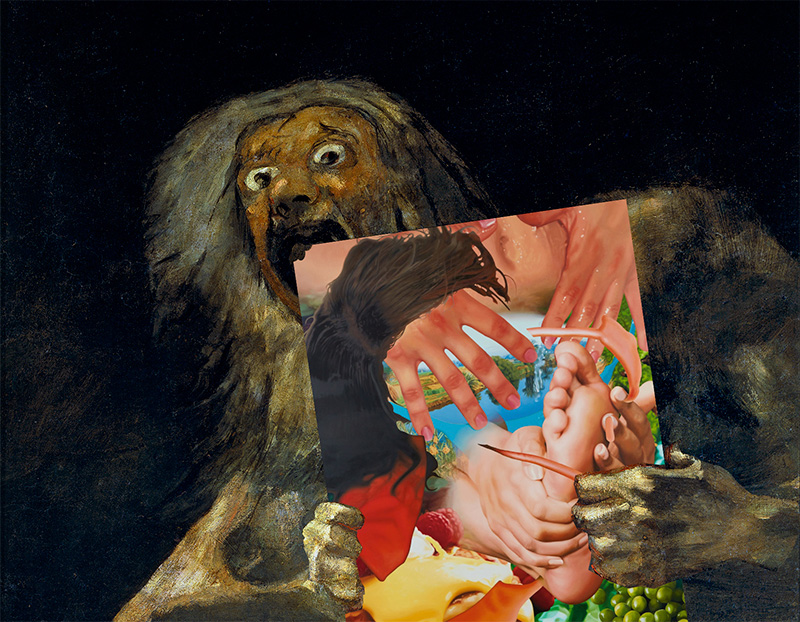Bangkok, Thailand. 03 November 2023 (2566!).
An arguably unkind thought occurred to me while listening to an interview with an artist given to US-academic critical word salad, and large opaque works, and assistants in her studio.
The thought:
Every artist has an obligation to talk about their work in terms the laity can understand.
Of course I don’t really believe in the “obligation” of any artist to do or not do anything, and in societies where such obligations exist you usually end up with pretty bad art. (Hello, socialist realism! Hello, Marxist vocabulary applied to art criticism in late-Capitalist society!)
But would it kill you to just say “I make huge black blobs because I feel they are an expression of mystical history, and between rich collectors and the grant system I manage to keep a staff to help me build them, which I need because some of them are really effing huge?”
 Blob not to scale.
Blob not to scale.
As long as I’m being a grumpy old representative of the as-yet unsmashed patriarchy, I also wish to grumble about –
Gigantism
Or, the insistence by artists, especially painters, on making artworks so big it’s very difficult to store them, and only the very rich and/or institutions can possibly collect them.
I get it, it’s a flex, and you’re going for your moment in the well-paid sun, and anyway storage space is cheap enough that for you, the artist, it’s a rational bet: I will court the Very Rich, and if I am successful I have this catalog of vast artworks ready to sell; if I’m not, whatever, I’m going to end up in the degree mills anyway and I can scratch my ego at the faculty show, maybe it’ll even get me laid.
And it’s not like massive paintings are new. It’s just that massive paintings by young, unproven, probably minor artists are now so much A Thing that I have to extend extra praise to anyone who actually makes decent artworks under a square meter.
At a recent show full of what I guess, nowadays, I have to call “Size M” paintings (and a couple of “L” and one “XL”) I bought some sweet little ones that I think were as good as any of the big ones. But cheaper, and easier to manage, and you can take them in your hand and contemplate them, and so on.
But that show, ironically, got me thinking that I, yes I too, FFS even I, need to start making larger works. Just because so many of the exhibition spaces I could realistically get my hands on (yes, pay-to-play, what of it?) are so massive, I fear my modest little collection of faces would not hold its own. I yearn for the old-school small gallery… which, sure, probably I will start on my own one day. Just to do it.
I don’t mean to completely discount the “human-scale” effect, as explained to me by an artist I know. And I surely will end up with more giant paintings of my own, and by others, on my walls and probably in my storage as well. But in addition to all that, I say show the good work at 40x50cm or smaller. If you have none, I’m not sure I trust your motivations.
I’m considering submitting a proposal for a multimedia work and I think the work itself is good at almost any size, let’s say a 24“ monitor and a shelf of the same width, that would be enough. But I worry that if I don’t say it has to be a full-room projection then people will not take me seriously. Which is nuts, but here we are. (Where are we?)
OK, here’s a thought, then I’ll shut up about the gigantism of contemporary painting:
Rent a storage unit and fill it with giant paintings bought at a discount from artists who are making huge paintings but failing to sell them to rich collectors. When it is full, abandon it. Document everything.
 ¡Vamos Gigantes!
¡Vamos Gigantes!
Drawn And…
Lately I’ve been thinking about what to do with my smallest works. Of which there are certainly some tiny ones, but most of these are more or less A5 in size and most are drawings, some are watercolors, a very few are mixed media… oh and I have a bunch of similar-sized acrylic paintings too. Shit. But let’s just talk about the A5 drawings, to keep things simple.
If I had a larger audience I would probably just give them away, in order to build followers. I’m sure there’s a social-media strategy for that. After all, these things just keep getting made, why not just send one out to a fan every week? (Haha, assuming one has fans… which is another thing. But if I ever get better at the Social Media Game, then maybe, sure, why not, if some of the people I follow did this I’d always sort of live in hope that I would win the luck draw.)
If I manage to sell things in the shop (ever!) then I might throw one in with every purchase of a painting. Someone did that when I bought from her and it was a really nice gesture.
Or I could try to sell them for Very Cheap, at a loss really if you count my labor – even the labor of posting it – at, say, minimum wage. But I don’t know, it seems like the hurdle is getting people to buy art at all, and not necessarily getting them to buy the supercheap instead of the merely inexpensive.
But isn’t this a problem every painter faces, at some level? Say you’re Cecily Brown. Surely you produce more drawings – even just the keepers – than it would be wise to put on the market?
No, bad example: she’s a very hard-working artist so let’s say she makes a dozen keeper sketches a week, just counting the simple one-off things in the studio. She’s famous enough that even if she keeps them in an archive, the archive will some day be “gifted” to an institution and they will be studied, and so on. And if she wanted to sell them, well, she probably doesn’t actually need the money but let’s say – I think you could reliably sell five a week for $10K each – her monotypes are something like $45K it seems – and neither spoil the market nor have to bother listing them online, just let the gallery dole them out to people waiting in line for a painting.
Yeah, but so then there is everyone else, and I bet you that Olschbaur makes a metric shit-ton of sketches for every finished painting. What does she do with them all? Probably same-same, keep for the eventual archive and so on as she’s well on her way to that same level of fame. Oder?
I suppose I’m not solving this problem today. But really, I would rather find homes for all these little things, than have them sit in their tiny portfolios and little metal boxes inside bigger metal boxes inside yet-bigger metal building-boxes. Where will it all go?
In closing, here is one such:
 Sketch, November 2023.
Sketch, November 2023.